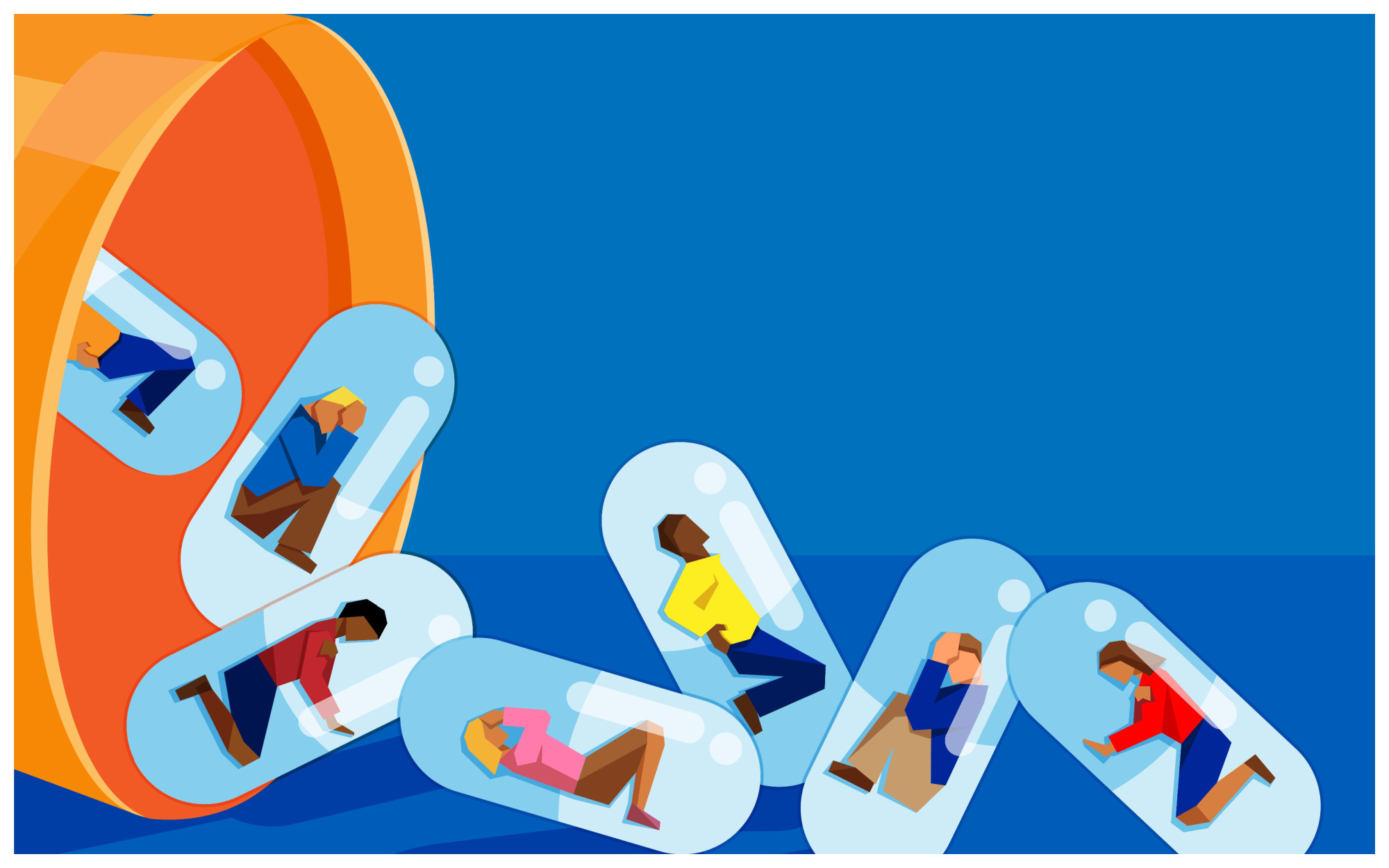Staci James walks in a crowd, yet alone with her thoughts. On either side of her, other family members move in the same somber manner. They are all related, these strangers, though truth be told they wish they weren’t. No one talks, but everyone shares the same story.
It’s a brilliant day for the gathering. The website calls it a walk to remember but that’s not the half of it; this event is, at once, a reminder, a warning, a scream of anguish, a punch thrown at a cosmic wall. Every family carries a piece of poster board with a picture of those who have been lost. Teenagers in prom gowns, athletes in letter jackets, young adults at their brightest and boldest. The families hold the images aloft like patron saints.
Staci holds hers up, too, of a gentle-faced young man looking steadily into the camera. “I didn’t even know what fentanyl was,” Staci says of her son, Hagen, the young man pictured on the poster with the words “Forever 22” printed on it. “So, I began this journey into opioids, I began this journey specifically into fentanyl. Where is it coming from? What is it? How did it find its way to Little Rock, Arkansas? That’s not supposed to happen here. We’re a neighborly state, we’re good people, we raise our kids right. It’s not supposed to happen.”
***
In Greek mythology, Pandora was given a box by the gods containing every evil in the world. When Pandora opened it all the miseries of mortal life escaped to infest mankind; only hope remained in the box. Over time, the legend of Pandora has been used as a metaphor for unleashing something that draws with it many other consequences both foreseen and unforeseen.
In the modern world, pharmaceuticals can be viewed as a Pandora’s box, created to ease human suffering yet also paving the way for abuse, addiction, and death. The most dangerous of these, prescription opioid painkillers, are a prime example. Morphine, codeine, hydrocodone, oxymorphone and others were all developed to help the severely injured and terminally ill, yet today are at the heart of a plague that rivals anything the human race has ever seen.
As time has gone along, pharmaceutical companies have refined their products to overcome human tolerance to previous prescriptions. Along with potency has come abuse and addiction, even when taken as directed. In some cases, people became dependent on opioids “accidentally” while taking the pills for a legitimate malady. In other cases, physicians over-prescribed the drug, sending home a month’s supply for a week-long recovery, feeding into humans’ seemingly bottomless belief that if one is good, might as well take three.
In still other cases — as with OxyContin, introduced in 1996 — manufacturers would later be found to have misled the public and the medical community, downplaying the addictive nature of the drug, turning many physicians (complicit or otherwise) into street-level pushers.
However it started, opioid abuse has become a full-blown health crisis worldwide and fast, starting with OxyContin, which flooded the market both for legitimate use and through intentional and unintentional over prescription. Suddenly, an endless stream of powerful narcotics was flowing into American homes, as close as millions of bathroom medicine cabinets. Pills began spilling out into the street to be swallowed or crushed for injection or snorting. In time, per CNN’s Sanjay Gupta, the U.S. would gobble up eighty percent of the world’s supply of opioids.
By 2007, Purdue Pharma, the creator of OxyContin, admitted to lying about the addictive properties of their product and would eventually agree to pay billions in fines and to settle various lawsuits. But by then, Pandora’s box lay in splinters and even hope had fled the scene. When the settlement was announced in 2020, overdose deaths in the U.S. would hit ninety-two thousand that year, two-thirds of which were opioid related.
Even the cleanup to this toxic mess had collateral damage; when OxyContin was redesigned to reduce the addictive properties and make it harder to shoot, patients looked for something to replace it. Heroin, to be precise — cheaper, readily available, and more than happy to pick up where pills left off.
Just like the Greek myth, opioids themselves didn’t stop with OxyContin. By 2011, a little-known but powerful anesthetic developed in the 1950s called fentanyl had started to factor heavily into overdose deaths. Fifty to one hundred times stronger than heroin, fentanyl was increasingly being mixed in with other substances such as cocaine, and stories of overdose deaths after just one ingestion became more and more common.
This is exactly what happened to Hagen and many more like him.
***
“Unfortunately, that last weekend when he was out with his buddies, he encountered fentanyl,” Staci says. “There was fentanyl in the cocaine and toxicology stated that there was five times the lethal dose. Hagen didn’t stand a chance.”
And so, Staci, a paralegal, who admits she couldn’t even spell fentanyl initially, became a committed crusader to unmask the face of her son’s killer.
“When your child is murdered, you want to find out everything you possibly can about who and what killed him,” she says. “I went to the Southwestern U.S. border to attend a law enforcement briefing in that area. I’ve been to D.C. several times. I’ve been to the DEA headquarters with their family summit, and I’ve met families from across the nation. I now have knowledge that is terrifying.”
The devastating effects of opioids has caused a marked decrease in prescription rates across the country. According to the Centers for Disease Control, the national opioid dispensing rate dropped below forty prescriptions per one hundred individuals in 2022, compared to about forty-seven prescriptions in 2019. Arkansas, unfortunately, remains one of the most heavily prescribed states in the nation, with more than seventy-two prescriptions per one hundred people in 2022. Only Alabama ranks higher, per the CDC.
Moreover, five Arkansas counties ranked in the top fifty nationwide in 2022 for opioid prescriptions, led by Baxter County which ranked fifteenth at one hundred sixty-four prescriptions per one hundred residents. Craighead County ranks twentieth at one hundred forty-two prescriptions and Independence County was twenty-seventh at one hundred thirty-three prescriptions. Rounding out the state’s top five were Garland County, ranked thirty-fifth at one hundred twenty-nine prescriptions, and Pulaski County, thirty-eighth nationally, at one hundred twenty-seven prescriptions per one hundred residents.
Locally, Sebastian County is a mixed bag when it comes to drug addiction. The county prescribed seventy-three prescriptions per one hundred individuals in 2021, according to the Arkansas Department of Health, which is an average of four prescriptions below the state’s average. This occurred despite being surrounded by counties with much higher rates of prescription. Averaged together, Crawford, Franklin, Logan and Scott issue just under one opioid prescription for every man, woman and child living in those areas.
However, Sebastian County was the highest in Arkansas in overdose deaths across all categories of drugs in the first six months of 2023 at fourteen deaths per one hundred thousand residents, the Department of Health reported. Only two other Arkansas counties averaged double-digit rates of overdose death in that period, Pulaski County at eleven deaths and Garland County at ten deaths per one hundred thousand residents.
In 2022, Sebastian County, at twenty-seven deaths, was second highest behind Clay County in a group of eleven counties to finish the year at twenty overdose deaths or more per one hundred thousand residents. Seven Arkansas counties recorded thirty or more deaths, led by Calhoun County at thirty-eight per one hundred thousand residents.
Of course, none of this takes into account the amount of opioids, including fentanyl, being trafficked illegally, particularly given the ongoing situation at the nation’s southern border. U.S. Customs and Border Protection reports fentanyl seizures have increased more than eight hundred percent since fiscal year 2019, and fiscal year 2023 seizures (commencing last October) have already surpassed fiscal year 2022’s total fentanyl seizure.
“We’re seeing a lot of synthetics,” says Kirk Lane, director of the Arkansas Opioid Recovery Partnership, whose career in law enforcement and government agencies addressing drug abuse spans forty years. “The whole thing about drug dealing and the whole drug industry is it’s all about profit and money. It’s not about getting high. It’s not about getting medication.
“What’s scary about drugs today is they can end your life. We didn’t see that in the years past in my career. Yeah, there were some people dying from fatal overdoses, you saw it in the olden days in the heroin overdoses, but what’s happened is when big pharma crossed the line, it led society into a mindset of ‘It’s from the doctor, it’s safe, my doctor wouldn’t hurt me.’ There’s still that mindset that any kind of pills are safe because they come from a pharmacy, even if I take somebody else’s pills.”
Kirk says the current epidemic is also fed by the persistent stigma that still hangs over some aspects of mental illness, such as substance use disorder.
“You still have society seeing problems of mental health and turning to law enforcement and the courts to solve those problems. That gives everything a criminal-type aspect,” he says. “Instead of looking at substance use disorder and opioid use disorder as a disease and treating it like a disease, we criminalize it, and we create the stigma that makes it so difficult for us to get past because people won’t come forward and be honest because of their embarrassment and the stigma that’s out there.”
Despite the massive scope of the problem, there are efforts being made in Arkansas to help individuals get their lives back in order, even if their addiction has led them to be incarcerated. Kathy McConnell is director of the Pulaski County Jail re-entry program, which helps inmates address issues in their lives, including addiction.
“We have a program schedule going on all the time in our unit that are peer-led groups, and we have volunteers that come in and teach,” Kathy says. “The volunteers come in and pour love and hope into people. It’s just amazing because so many who are in our program have addiction issues, years of addiction issues and generations of addiction issues. For at least eighty percent of them, it may look like they simply committed armed robbery or breaking and entering, or battery, but it’s all fueled by alcohol or drug addiction.
“Our volunteers teach programs such as Inside Out Dads, a parenting program for men taught by a graduate of our program who got out and wants to come back and help. Series 33 Authentic Manhood is a course taught by three young men from the Nehemiah House who are all graduates of the program and are doing very well there. They want to come back and help.”
Throughout talking about the program, Kathy wisecracks about being too old for this kind of work, but a note in her voice tells the listener her mission is very personal. Like Staci, she lost a child to fentanyl and sees the inmates as a chance to spare another family from experiencing similar loss.
“My son, Matthew, was in active addiction pretty much from the time he was in the tenth grade until he died at thirty-three,” she says. “We didn’t know anything about addiction when he first started. It was hidden, it was a secret, it was a moral issue. And a lot of bad stuff happened. A lot of pawn shops, a lot of police, a lot of hospitals. Just a lot of ugliness.
“You develop a lot of things between you and your loved one in addiction that prevent your loved one from really listening to you and from you looking at them objectively because they are your loved one. Now, I’ve been able to channel that and when I walk into a room it’s obvious, I’ve never been incarcerated, I’ve never had drug issues, but when I start talking, they know I know. And many of them may not realize what they’ve done to their families and that’s an important thing that we always teach is victim impact.”
Kirk says despite Arkansas’ poor showing nationwide, the state does continue to make progress. Most of the tale is a good-news-bad-news proposition, however: The good news is the state has seen a seventeen percent reduction in overdose deaths over the past several years; the bad news is, the annual death toll due to overdose still equals more than four hundred Arkansans, roughly equivalent to the population of Subiaco in Logan County.
“People ask me, ‘What does the number need to be?’” Kirk says “Well, it needs to be zero. That’s what our goal is. One person dead is too many.”
Until that happens Staci will be there to serve families who have lost loved ones. She and two other moms who have lost children to overdose formed the nonprofit Hope Movement Coalition through which she serves the grieving, be they parents, siblings, or spouses.
“I call it an assault of grief,” she says. “In many, many ways it is like a traumatic brain injury, and I don’t say that lightly, nor do I say it to disrespect anyone that has encountered that. I don’t see life the way I did prior to March 19, 2019. It takes a great deal of inner strength that most people don’t even know they have just to get through the day sometimes. While we cannot take away what has happened, we can absolutely help them manage their traumatic grief.”
Hope Movement Coalition has grown its suite of services and operates in all seventy-five Arkansas counties. Helping others is therapeutic for Staci, who now devotes herself full time to the cause, but more importantly it helps people who need it. Like Kirk, she considers just one more empty chair at the dinner table, just one more child robbed of a parent or the addition of just one more poster at the next memorial walk to be far too many.
“We’ll never make the pain stop,” she says. “But we want to help keep that family unit together. We want to be right there with them to say, ‘Hey, we’re here to help you make this work.’”
Hope Movement Coalition, hopemovementcoalition.com
National Drug Helpline, 844.289.0879
SAMHSA’s National Helpline (treatment referral) 800.662.4357
Arkansas Department of Health, healthy.arkansas.gov
Download the ReviveAR app by the Arkansas Opioid Recovery Partnership for information and resources, arorp.org.




